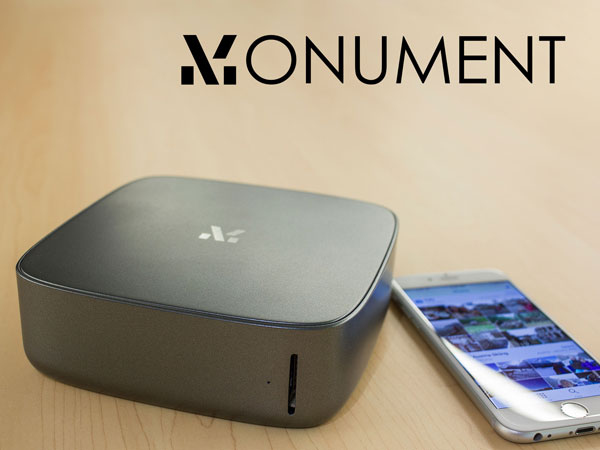Welcoming our tech guru Brantlea Newbury back this week with an expert overview of a new storage tool:
I have over 6,000 photos on my iPhone right now. You probably have thousands too and I wouldn’t be surprised if you have to constantly delete photos because you run out of space on your phone. That’s just on my phone, not to mention all the other photos scattered on my computer, external hard drives, DropBox, and Google drive. With every passing day that number of images (and video) gets bigger and bigger. Managing all those photos is a Sisyphean task. Professionally, I manage image libraries but my personal collection is, more of a mess than I care to admit. I could be using Apple’s built in Photos app on my Macs but I’ve never been a fan of it (I use Adobe Lightroom) .

What is Monument?
Monument is a little box-shaped device that houses one or two standard external USB drives and the Monument hardware. It’s unique because you provide the drives, which is great because you can swap them out for more storage as needed (you may even already have a drive you can use).
Monument requires a wifi network to transfer and view images across all your devices. When you launch the Monument app from your phone/tablet/computer, it will import photos and videos from that device to the Monument drive. The same goes for your desktop computer; use the Monument application to import your photos to the Monument device and then all of your pictures will live in one tidy little spot. You can setup Monument to automatically import photos whenever your device is connected to your home wifi network to make backup seamless or choose when you want to sync images.
One big happy Family.
A really cool feature is it’s multi-user compatible so each person in your household can upload to Monument, so all the photos are in one searchable place regardless of who snapped the picture. (Not to worry, there will be privacy options for each user, like the ability to share only certain albums and turn off auto-uploading). Monument hooks up to your TV via HDMI too, so you can all kick back on the couch and use your phone or tablet to create slideshows instead of huddling around one little screen. It’s cross platform too- so it could be an elegant solution for households with both Macs and PC’s, Androids, and iPhones.

It’s in here somewhere.
Just getting all those photos in one place is great, but to make it possible to find your photos, Monument’s software does some important things. It organizes your photos by date taken, camera, and location (if location info was embedded by the camera-it won’t help with your older photos). To filter images even further it automatically recognizes faces, detects scenes and allows you to add tags and of course, create albums.
Finally-one of my favorite features- it detects duplicate images so you can tidy up and save time searching through your photos.
Monument is a physical device that resides in your home, so it offers some advantages over cloud-based storage. The cloud requires considerable bandwidth to upload large batches of images and videos that makes it unrealistic for a large photo library. With Monument you can copy your images directly to your computer to migrate large batches of images by one of two ways; SD card, or directly via the USB hard drive. If you shoot with a camera that uses an SD card, you can copy the photos directly to Monument by putting the card in the slot. Or, and this part I really like, you can disconnect the Monument hard drive and connect it directly to your computer to copy over huge folders of images all at once. When you plug the drive back into Monument, it’ll recognize there are new photos to import. That’s really powerful and will likely make it possible for me to migrate all my existing photos that are currently scattered all over the place.
Backups and scalability
Monument has the ability to connect two external USB drives and set one up as a backup to the other (should one drive fail, you aren’t screwed). To be super-safe, ideally you would have a backup in another location, like at the office or your best friend’s place. You can purchase a second Monument and set it up identically and configure them to backup via the internet. The folks at Monument say it won’t be difficult, and I’d certainly try it. The images still wouldn’t be stored in the cloud, but you’d have physical copies in two separate locations, which is really solid. In the future they may add some kind of cloud integration as well. The other big benefit of Monument using external USB drives, is that you can swap them out for larger drives as you amass more images.
All in all, it’s an intriguing product and I can’t wait to get my hands on one to see if it delivers. Monument starts shipping in September, but can be pre-ordered on indiegogo now for $109. After pre-ordered units ship, it will be available on Amazon sometime later (at a higher estimated cost of about $200). You’ll also need to purchase the external hard drive to use with Monument, but you can get a great 1TB drive for only $60 (and if you’re smart, you’ll buy two so one backs up the other).

.

 Brantlea Newbery is an expert in digital imaging and archive management. She has created digital workflows, image quality standards, and educational programming for Corbis, PictureArts, Jupiter Images, deviantArt, and Venus Stock.
Brantlea Newbery is an expert in digital imaging and archive management. She has created digital workflows, image quality standards, and educational programming for Corbis, PictureArts, Jupiter Images, deviantArt, and Venus Stock.